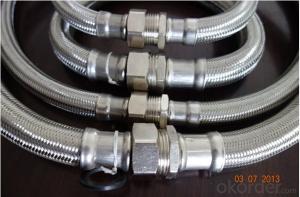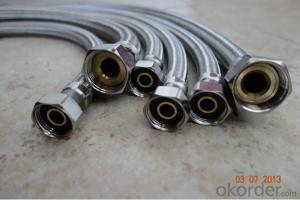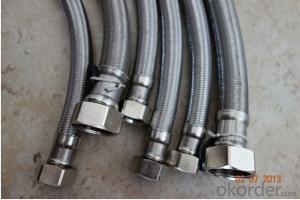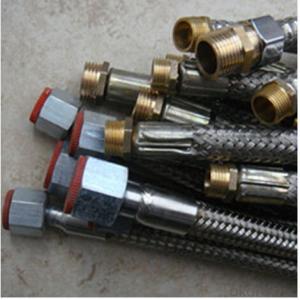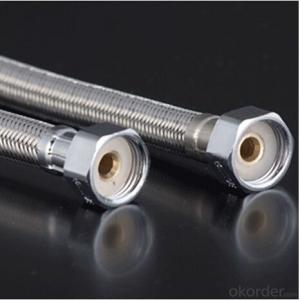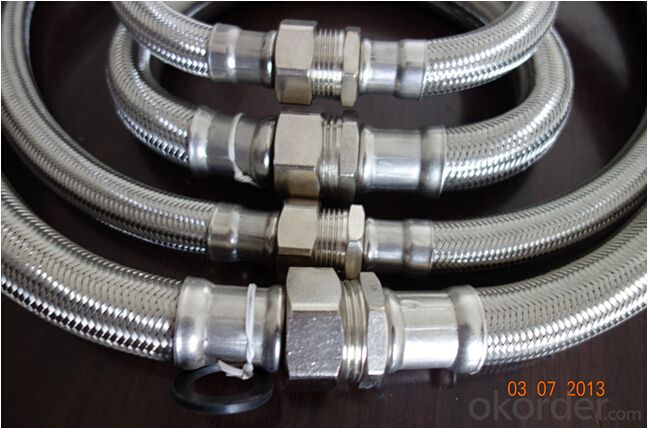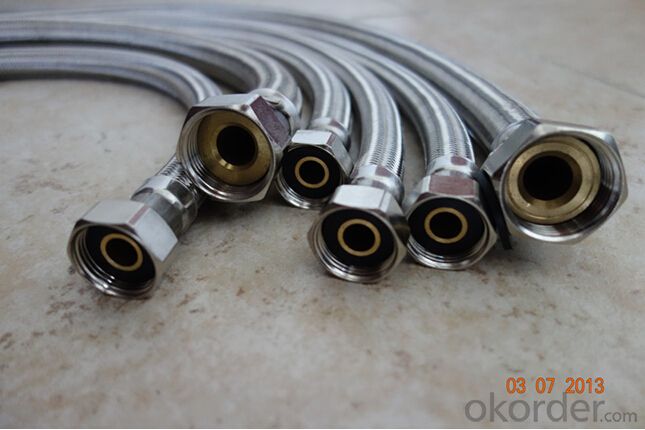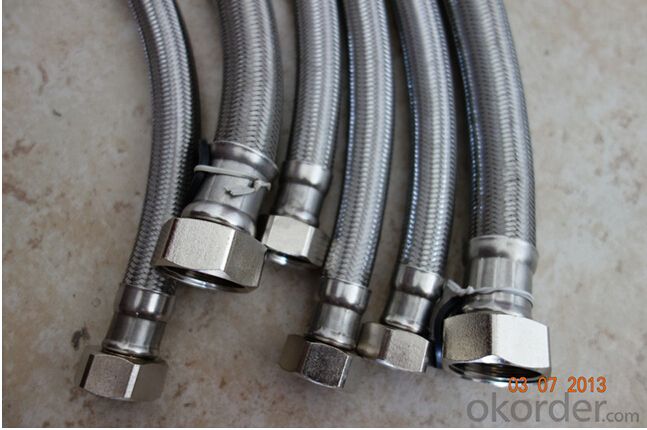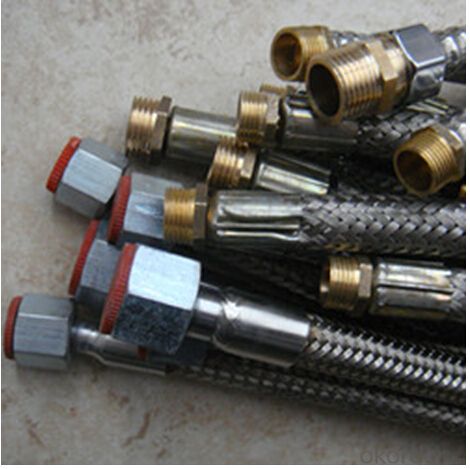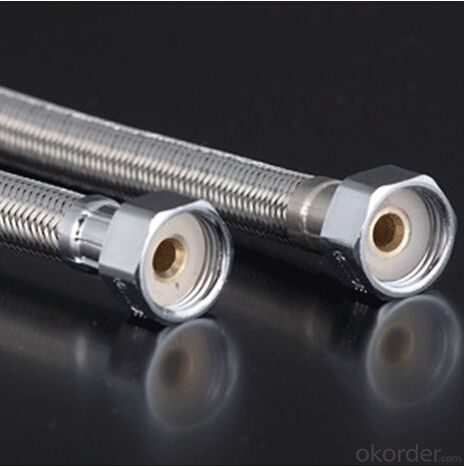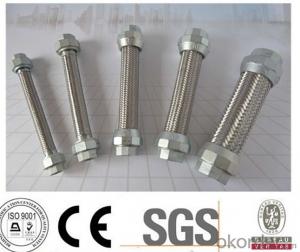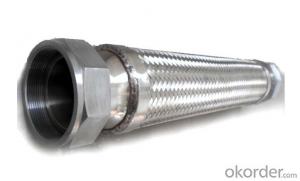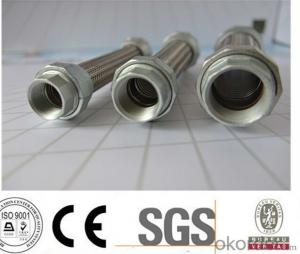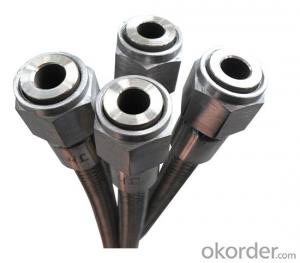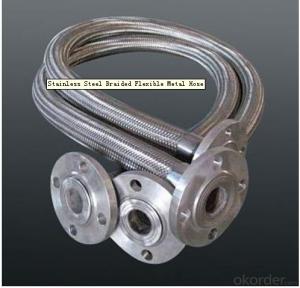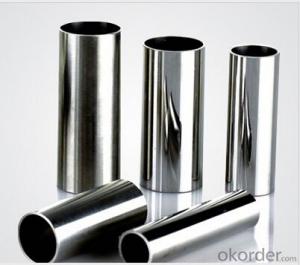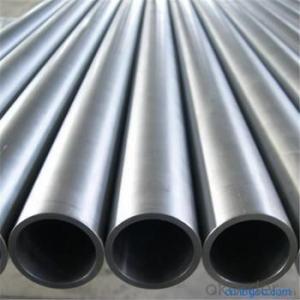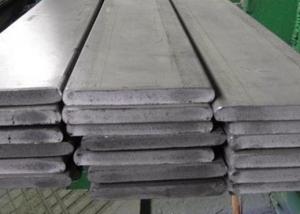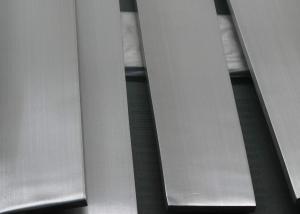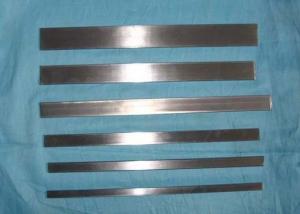Stainless Steel Braid Hose with Outside Fittings
- Loading Port:
- Tianjin
- Payment Terms:
- TT OR LC
- Min Order Qty:
- 1000 pc
- Supply Capability:
- 100000 pc/month
OKorder Service Pledge
OKorder Financial Service
You Might Also Like
Specification
Stainless Steel Braid Hose with Outside Fittings
Applications of Stainless Steel Braid Hose with Outside Fittings:
--Refueling system
--Chemical and pharmaceutical industry
--Industrial hydraulic systems
--Air conditioners in industrial and construction –site vehicles
--Food and beverage industry
--Special and standard industrial applications
--Water and cleaning management
Features of Stainless Steel Braid Hose with Outside Fittings:
1. )O. D.: 13-18MM 0.2-3M long
2. )Nut.: Nickel/Chrome Plated Brass (Zinc / Iron / Aluminum is available)
3. )Size Of Nut.: Female&Male 1/2''; 3/4''; 3/8''; 7/8''; 5/16'', and M10...
4. )Insert.: Brass (Zinc / Aluminum / Plastic is available)
5. )Inner tube.: Rubber/ EPDM/PVC
6. )Covered Material: Stainless Steel 201, 301, 304 /Aluminium Wire
7. )Working Pressure: 5Kg-15Kg
8. )Temperature: 0-92° C
9. )Quality Assurance: 3 years
RemarkAPPLICATION: HOUSEEHOLD WARE, BATHROOM WARE, SHOWER HOSE
PAYMENT: T/T, L/C
DELIVERY TIME: 20DAYS OR 30DAYS AFTER RECEIVED 30% DEPOSITS
MOQ: 5000PCS
ODM&OEM IS ACCEPTABLE
PackageInner: PP bag /Blister packing Outer: Carton box
Specifications of Stainless Steel Braid Hose with Outside Fittings:
NO | I.D | Refer to O.D | Working pressure | Burst pressure | approximate Weight | |||||
(inch) | (mm) | (inch) | (mm) | MPa | Psi | MPa | Psi | kg/m | lbs/ft | |
1 | 1/8 | 3.2±0.2 | 0.35 | 9±0.3 | 2.06 | 300 | 8.27 | 1200 | 0.078 | 0.12 |
2 | 5/32 | 4±0.2 | 0.4 | 10±0.3 | 2.06 | 300 | 8.27 | 1200 | 0.092 | 0.14 |
3 | 3/16 | 4.8±0.2 | 0.43 | 11±0.3 | 2.06 | 300 | 8.27 | 1200 | 0.108 | 0.16 |
4 | 1/4 | 6.3±0.3 | 0.5 | 12.7±0.3 | 2.06 | 300 | 8.27 | 1200 | 0.134 | 0.2 |
5 | 5/16 | 8.0±0.3 | 0.56 | 14±0.3 | 2.06 | 300 | 8.27 | 1200 | 0.147 | 0.22 |
6 | 3/8 | 9.5±0.3 | 0.63 | 16±0.4 | 2.06 | 300 | 8.27 | 1200 | 0.182 | 0.27 |
7 | 15/32 | 12±0.3 | 0.75 | 19±0.5 | 2.06 | 300 | 8.27 | 1200 | 0.238 | 0.35 |
8 | 1/2 | 12.7±0.4 | 0.78 | 20±0.5 | 2.06 | 300 | 8.27 | 1200 | 0.262 | 0.39 |
9 | 5/8 | 16±0.4 | 0.94 | 24±0.5 | 1.03 | 150 | 4.12 | 600 | 0.351 | 0.52 |
10 | 3/4 | 19±0.4 | 1.13 | 28.8±0.5 | 1.03 | 150 | 4.12 | 600 | 0.515 | 0.77 |
11 | 1 | 25.4±0.5 | 1.38 | 35±0.6 | 1.03 | 150 | 4.12 | 600 | 0.637 | 0.95 |
Images of Stainless Steel Braid Hose with Outside Fittings:
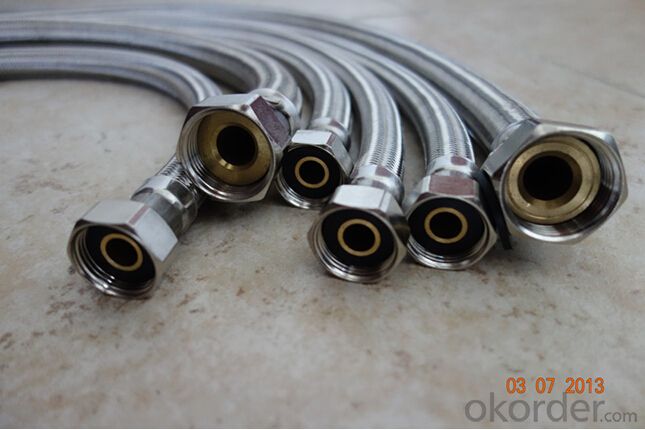
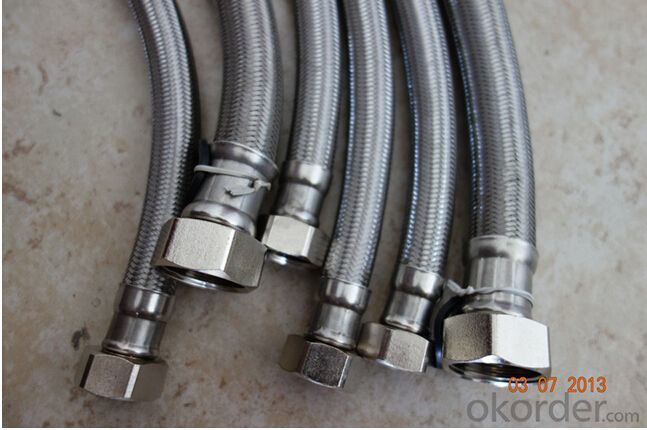
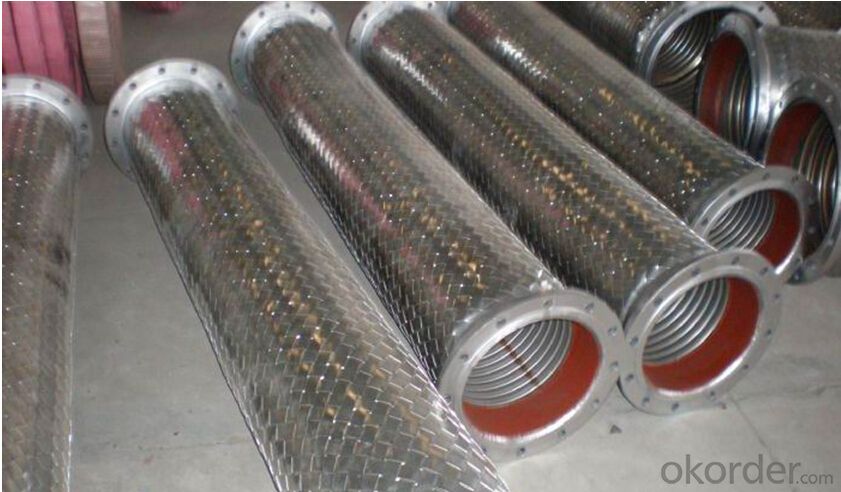
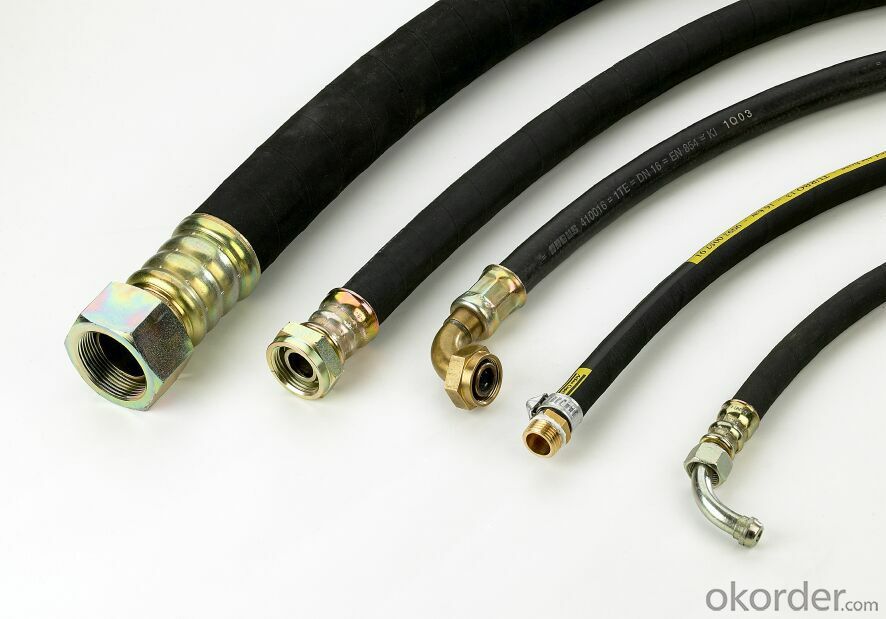
Package of Stainless Steel Braid Hose with Outside Fittings:
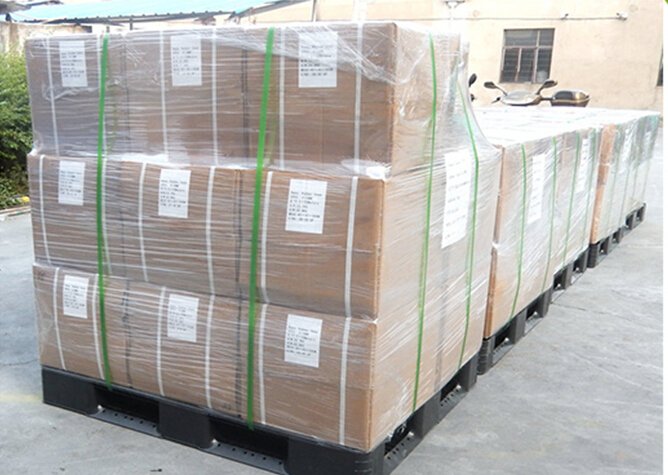
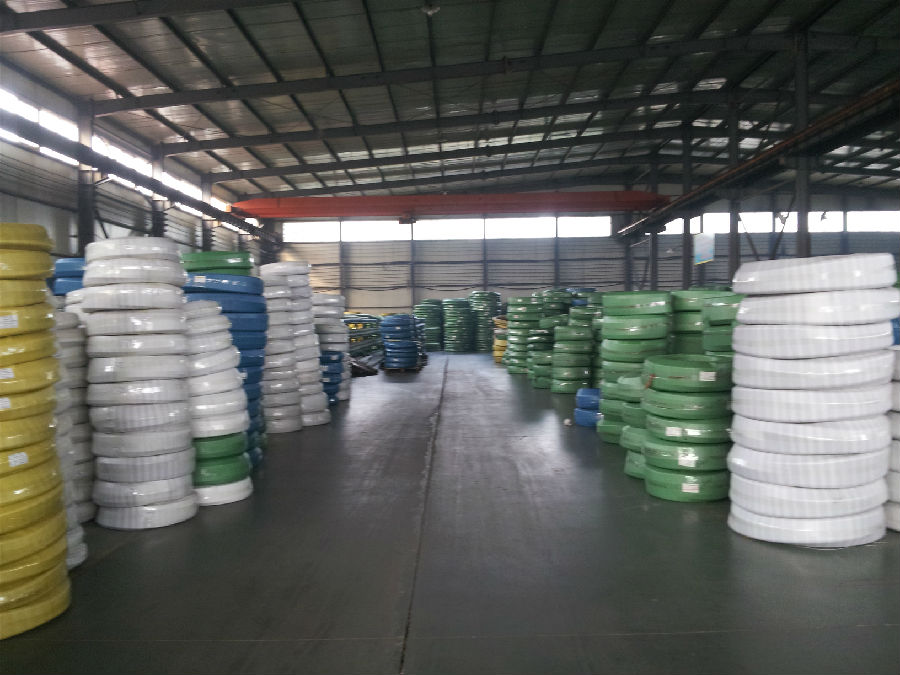
FAQ of Stainless Steel Braid Hose with Outside Fittings:
Who we are:
Answer: We CNBM is a Chinese state-owned enterprise ranked 267th among the Global Fortune 500, as the largest building materials company,we have over 300 affiliated companies,and so many production lines and branch office distribute in China.
2. About our quality:
Answer: Every product needs to be quality proved before shipping.
3. About our service:
Answer: We could gurantte that we can reply you in 2 working hours.
- Q: What is the difference between bright annealed and annealed pickled stainless steel pipes?
- Bright annealed and annealed pickled stainless steel pipes differ in their surface finish and treatment processes. Bright annealed stainless steel pipes undergo a heat treatment known as annealing in a controlled atmosphere to eliminate internal stresses and improve the material's ductility. This process also results in a bright and shiny surface finish, making the pipes suitable for applications that require an aesthetically pleasing appearance, such as decorative or architectural purposes. On the other hand, annealed pickled stainless steel pipes undergo a two-step treatment process. First, the pipes are annealed to remove any stresses and improve their mechanical properties. Then, they undergo a pickling process where the surface is chemically treated to remove scale, oxides, and other impurities. This treatment leaves the pipes with a dull and rough surface finish, which is often desired for applications that require subsequent coatings, such as painting or galvanizing. In summary, the main difference between bright annealed and annealed pickled stainless steel pipes lies in their surface finish. Bright annealed pipes have a bright and shiny appearance, while annealed pickled pipes have a dull and rough surface finish due to the pickling process. The choice between the two types depends on the specific requirements of the intended application.
- Q: What's the difference between stainless steel 302 and 304?
- Type 302 - 304 with corrosion resistance, due to the relatively high carbon intensity. Model 304 - general model: 18/8 stainless steel. GB is 0Cr18Ni9. 302 and 304 stainless steel is widely used in curtain walls, side walls, roofs and other building applications. These two, I think, are basically different. The quality and texture are almost the same.
- Q: Can stainless steel pipes be insulated with cork?
- Certainly! Insulation of stainless steel pipes with cork is indeed possible. Cork, a versatile material, finds wide application in insulation. Its insulating properties are exceptional, encompassing thermal insulation, noise reduction, and fire resistance. Cork insulation proves suitable for diverse purposes, including pipes, as it efficiently curtails heat transfer and averts condensation. Moreover, cork stands as an environmentally friendly and sustainable choice, rendering it highly favored for insulation. Consequently, employing cork for insulating stainless steel pipes emerges as a feasible alternative.
- Q: How do stainless steel pipes compare to cast iron pipes?
- There are two popular options for plumbing systems: stainless steel pipes and cast iron pipes. However, these two choices have notable differences when it comes to durability, cost, and corrosion resistance. To begin with, stainless steel pipes are widely recognized for their exceptional durability. They possess a higher strength-to-weight ratio and are less susceptible to cracking or breaking in comparison to cast iron pipes. Consequently, stainless steel pipes are well-suited for high-pressure scenarios or areas with heavy traffic. On the contrary, cast iron pipes have traditionally been acknowledged for their strength and longevity. They exhibit a remarkable resistance to impact and vibrations, which makes them ideal for locations where durability is of utmost importance, such as underground or in commercial buildings. Nevertheless, cast iron pipes are more prone to cracking or corrosion over time, particularly in acidic or alkaline environments. In terms of costs, stainless steel pipes generally require a higher upfront investment in contrast to cast iron pipes. Nonetheless, stainless steel pipes boast a longer lifespan and demand minimal maintenance, ultimately resulting in cost savings in the long term. Conversely, cast iron pipes may entail lower initial expenses but may involve more frequent maintenance and repairs, consequently escalating the overall costs over time. Regarding corrosion resistance, stainless steel pipes surpass cast iron pipes. Stainless steel contains a substantial amount of chromium, which forms a protective oxide layer that prevents corrosion. This characteristic renders stainless steel pipes highly resistant to rust, chemicals, and extreme temperatures. Conversely, cast iron pipes are more prone to rust and corrosion, especially if not adequately coated or maintained. In summary, stainless steel pipes offer superior durability, corrosion resistance, and long-term cost savings compared to cast iron pipes. Although cast iron pipes possess their own advantages, such as strength and impact resistance, stainless steel pipes emerge as a more reliable and versatile option for various plumbing applications.
- Q: What are the different types of fittings used with stainless steel pipes?
- There are several different types of fittings that can be used with stainless steel pipes, depending on the specific application and requirements. Some of the most common types include: 1. Compression fittings: These fittings are designed to create a leak-proof connection by compressing a ferrule onto the pipe. They are easy to install and can be used with both rigid and flexible stainless steel pipes. 2. Threaded fittings: Also known as screwed fittings, these fittings have female threads that allow them to be screwed onto the male threads of the pipe. They are commonly used in low-pressure applications and can be easily installed or removed. 3. Butt weld fittings: These fittings are used to create a permanent, welded connection between two stainless steel pipes. They require the pipes to be beveled to create a V-shaped groove and are typically used in high-pressure or high-temperature applications. 4. Flange fittings: Flanges are used to connect two stainless steel pipes or to connect a pipe to a valve, pump, or other equipment. They provide a strong and leak-proof connection and can be easily bolted or welded onto the pipe. 5. Push-to-connect fittings: These fittings are designed to provide a quick and easy connection without the need for tools or soldering. They use a push-in mechanism to secure the pipe and are commonly used in plumbing and air compression systems. 6. Camlock fittings: Camlock fittings are used to quickly connect or disconnect hoses and pipes. They have a lever or cam mechanism that locks the fitting into place, ensuring a secure connection. They are commonly used in industrial applications where frequent connections and disconnections are required. Overall, the choice of fitting will depend on factors such as the application, pressure requirements, and ease of installation. It is important to select the appropriate fitting to ensure a reliable and durable connection for stainless steel pipes.
- Q: What is the maximum temperature that stainless steel pipes can withstand?
- The maximum temperature that stainless steel pipes can withstand depends on the grade of stainless steel used. Generally, stainless steel pipes can withstand high temperatures ranging from 1200 to 1600 degrees Fahrenheit (650 to 870 degrees Celsius). However, it is important to note that prolonged exposure to these extreme temperatures may cause the stainless steel to lose its strength and potentially result in deformation or failure. It is always recommended to consult the specific manufacturer's guidelines or a materials engineer to determine the maximum temperature limits for a particular grade of stainless steel pipe in any given application.
- Q: How do you prevent stress corrosion cracking in stainless steel pipes?
- To prevent stress corrosion cracking in stainless steel pipes, several precautions can be taken: 1. Material selection: Choose a stainless steel grade that is resistant to stress corrosion cracking. Austenitic stainless steel grades such as 304 and 316 are commonly used due to their high resistance to corrosion and cracking. 2. Proper fabrication and welding: Ensure that the welding procedures used during fabrication are suitable for stainless steel and minimize the introduction of residual stresses. This includes using proper welding techniques, maintaining appropriate heat input, and employing post-weld heat treatment if necessary. 3. Avoid exposure to corrosive environments: Protect stainless steel pipes from exposure to aggressive chemicals, high chloride concentrations, and other corrosive substances. Regularly inspect the environment and take necessary measures to prevent contact between the pipes and corrosive agents. 4. Control operating conditions: Avoid subjecting stainless steel pipes to excessive tensile stresses or temperatures that can promote stress corrosion cracking. This can be achieved by maintaining proper operating conditions, such as controlling pressure, temperature, and flow rates within the recommended limits. 5. Regular inspection and maintenance: Conduct regular inspections to identify any signs of stress corrosion cracking. This may include visual inspections, non-destructive testing techniques (e.g., ultrasonic testing), or corrosion monitoring. If any signs of stress corrosion cracking are detected, immediate action should be taken to repair or replace the affected pipe sections. 6. Proper cleaning and maintenance: Keep stainless steel pipes clean and free from contaminants that can accelerate corrosion. Regular cleaning and maintenance practices should be followed, including removing any deposits or foreign materials that may promote stress corrosion cracking. Overall, preventing stress corrosion cracking in stainless steel pipes requires a combination of proper material selection, fabrication techniques, environmental control, regular inspections, and appropriate maintenance practices. By implementing these measures, the risk of stress corrosion cracking can be significantly reduced, ensuring the longevity and reliability of stainless steel pipes.
- Q: Are stainless steel pipes resistant to chlorine corrosion?
- Yes, stainless steel pipes are highly resistant to chlorine corrosion.
- Q: Are stainless steel pipes suitable for fertilizer production?
- Yes, stainless steel pipes are suitable for fertilizer production. Stainless steel pipes offer a number of advantages that make them a preferred choice for use in the fertilizer industry. Firstly, stainless steel pipes are highly resistant to corrosion, which is particularly important in the production of fertilizers. Fertilizer production involves the use of chemicals and substances that can be highly corrosive, such as ammonia, sulfuric acid, and phosphoric acid. Stainless steel pipes can withstand the corrosive effects of these substances, ensuring the integrity and longevity of the piping system. Additionally, stainless steel pipes have excellent strength and durability, making them able to withstand the high pressures and temperatures often encountered in fertilizer production processes. This ensures the safe and efficient transportation of the fertilizer materials within the production plant. Furthermore, stainless steel pipes are hygienic and easy to clean, which is crucial for maintaining the purity of the fertilizer products. Stainless steel has a smooth surface that resists the buildup of bacteria, dirt, and other contaminants, ensuring that the pipes do not contaminate the fertilizer during production. Lastly, stainless steel is a sustainable and environmentally friendly material. It is 100% recyclable, making it a more sustainable choice compared to other pipe materials. Additionally, stainless steel has a long lifespan, reducing the need for frequent replacements and minimizing waste. In conclusion, stainless steel pipes are highly suitable for fertilizer production due to their corrosion resistance, strength, durability, hygienic properties, and environmental benefits.
- Q: What is the difference between 440C and 440F stainless steel pipes?
- 440C and 440F are both types of stainless steel that belong to the 440 series. However, they have slight differences in their composition and properties. 440C stainless steel is a high-carbon martensitic stainless steel that contains chromium, which enhances its corrosion resistance and hardness. It is known for its exceptional wear resistance, good strength, and ability to maintain sharpness. Due to its high carbon content, it offers excellent hardness, but it may be more difficult to machine compared to lower carbon stainless steels. 440C is commonly used in applications where high strength, corrosion resistance, and wear resistance are required, such as in cutting tools, bearings, and surgical instruments. On the other hand, 440F stainless steel is a free-machining version of 440C. It is also a high-carbon martensitic stainless steel but with added sulfur, which improves its machinability. The sulfur acts as a lubricant during the machining process, enabling easier and faster cutting. However, the addition of sulfur slightly reduces its corrosion resistance and toughness compared to 440C. 440F is often used in applications that require extensive machining, such as in automotive components, fasteners, and valve parts. In summary, the main difference between 440C and 440F stainless steel pipes lies in their machinability and sulfur content. 440C offers higher corrosion resistance and hardness but may be more difficult to machine, while 440F is easier to machine but has slightly reduced corrosion resistance and toughness. The choice between the two depends on the specific requirements of the application, with 440C being preferred for applications that prioritize corrosion resistance and wear resistance, and 440F being used when extensive machining is required.
Send your message to us
Stainless Steel Braid Hose with Outside Fittings
- Loading Port:
- Tianjin
- Payment Terms:
- TT OR LC
- Min Order Qty:
- 1000 pc
- Supply Capability:
- 100000 pc/month
OKorder Service Pledge
OKorder Financial Service
Similar products
Hot products
Hot Searches
Related keywords
